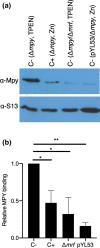Ribosome hibernation: a new molecular framework for targeting nonreplicating persisters of mycobacteria
- PMID: 33555244
- PMCID: PMC8131030
- DOI: 10.1099/mic.0.001035
Ribosome hibernation: a new molecular framework for targeting nonreplicating persisters of mycobacteria
Abstract
Treatment of tuberculosis requires a multi-drug regimen administered for at least 6 months. The long-term chemotherapy is attributed in part to a minor subpopulation of nonreplicating Mycobacterium tuberculosis cells that exhibit phenotypic tolerance to antibiotics. The origins of these cells in infected hosts remain unclear. Here we discuss some recent evidence supporting the hypothesis that hibernation of ribosomes in M. tuberculosis, induced by zinc starvation, could be one of the primary mechanisms driving the development of nonreplicating persisters in hosts. We further analyse inconsistencies in previously reported studies to clarify the molecular principles underlying mycobacterial ribosome hibernation.
Keywords: Mycobacterium tuberculosis; cryo-EM structure analysis; drug tolerance; nonreplicating persisters; ribosome hibernation; zinc starvation.
Conflict of interest statement
The authors declare that there are no conflicts of interest.
Figures





References
-
- WHO Rapid Communication: key changes to the treatment of multidrug- and rifampicin-resistant tuberculosis (MDR/RR-TB). http://wwwwhoint/tb/publications/2018/WHO_RapidCommunicationMDRTBpdf . 2018.
Publication types
MeSH terms
Substances
Grants and funding
LinkOut - more resources
Full Text Sources
Other Literature Sources
Medical

